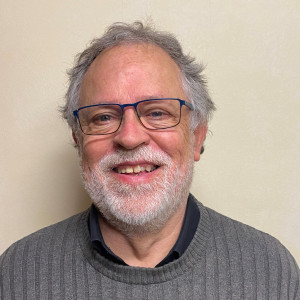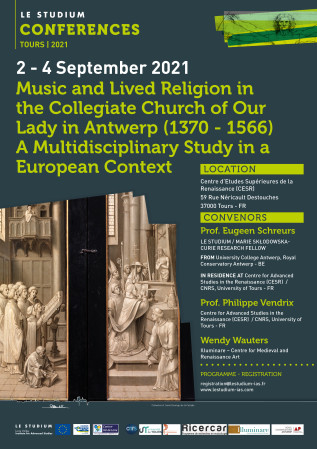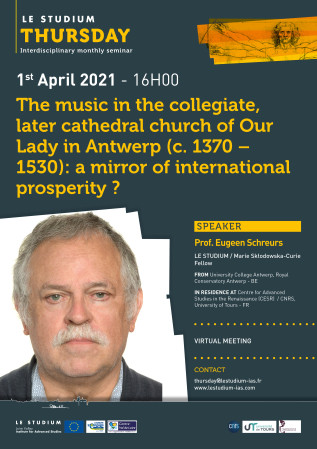Prof. Eugeen Schreurs

Period 2 January 2023 - Mai, 2023
Award LE STUDIUM Visiting Researcher
From
University College Antwerp, Royal Conservatory Antwerp - BE
In residence at
Centre for Advanced Studies in the Renaissance (CESR) / CNRS, University of Tours - FR
Host scientist
Prof. Philippe Vendrix
PROJECT 1
Music in the Collegiate Church of Our Lady in Antwerp (C.1370 - C.1530): An European hub?
Until now, research on music in the Collegiate Church of Our Lady in Antwerp has mainly focused on the ‘Golden’ sixteenth century, but not on the fifteenth when its foundations were laid. The latter period has not been the subject of a comprehensive musicological study meeting today’s scholarly standards, yet it was precisely then when composers of international renown were employed at Antwerp’s main church. This immense building, then still unfinished but with the magnetism of a Gothic cathedral, was the city’s musical epicentre. Composers such as Ockeghem, Barbireau, and Obrecht flourished here. Close ties with the chapels of both the Burgundian-Habsburg court and the pope, its position of favour with the Habsburg monarchs, bustling commercial contacts throughout Europe, and donations to the church from wealthy citizens wanting to ensure their salvation made it of northern Europe’s most important capitals, famous among many things for music.
The primary intention of this study is to arrive at a better understanding of the mechanisms underlying this rich music scene, and to place them in their urban, socio-cultural, and European contexts. This contextualization, along with an interdisciplinary approach to the issue, will undoubtedly provide a new and better explanation for the blossoming of this extraordinary musical culture.
The existing studies on the subject mostly consider the period after c.1490 and do not take account of an essential part of the cathedral’s archives or of the historical context and modern scholarly methods. The project described here proposes new approaches (e.g. urban musicology; comparative and interdisciplinary research) that consider music to be an essential element of a vital liturgical and urban context. This research will improve our understanding of how the many Renaissance compositions heard at the Church of Our Lady were performed and heard, and permit better historical reconstructions of their acoustical and visual environments.
PROJECT2
Music, performance and context: the Collegiate Church Of Our Lady in Antwerp in a european and multidisciplinary perspective (c. 1352-1566)
Until now, research on music in the Collegiate Church of Our Lady in Antwerp has mainly focused on the ‘Golden’ sixteenth century, but not on the period before when its foundations were laid. Yet it was precisely then when composers of international renown like Ockeghem, Barbireau, and Obrecht flourished here. Close ties with the chapels of both the Burgundian-Habsburg court and the pope, its position of favour with the Habsburg monarchs, bustling commercial contacts throughout Europe, and donations to the church from wealthy citizens wanting to ensure their salvation made Antwerp one of northern Europe’s most important capitals, famous among many things for music. The primary intention of this study is to arrive at a better understanding of the mechanisms underlying this rich music scene, and to place them in their urban, socio-cultural, and European contexts. This contextualization along with an interdisciplinary approach to the issue, will undoubtedly provide a new and better explanation for the blossoming of this extraordinary musical culture. This will also improve our understanding of how Renaissance compositions were performed and heard, and permit better historical reconstructions of their acoustical and visual environments as well as the reception of this music by the faithfull. The proposed research builds on an earlier successful project (1/9/2020-7/11/2021), realised with the support of LeStudium and the Ricercar programme (CESR). This previous research clearly showed that through as yet unknown archival and documentary material (for example in French collegiate churches) and via a thorough interdisciplinary approach, important new insights emerge. Some aspects are: 1) Comparative research into similar situations in (Northern) French collegiate churches, which in many respects show similarities 2) Intensification of interdisciplinary research that was also the theme of the Le Studium colloquium (9/2021) The basis was laid there for future cooperation with the main actors of this meeting. 3) Research in Vienna, Rome, Paris, Cambrai, cancelled during the previous research period due to Covid 4) Finishing an English/Dutch book (Brepols, 2024)
Publications
Final reports
The collegiate church of Our Lady in Antwerp played an important role in the development of polyphonic music in the Low Countries and Europe during the long 15th century, with first-rank composers such as Johannes Ockeghem, Johannes Pulloys, Jacobus Barbireau and Jacobus Obrecht as central figures. However, this period has received very little attention, perhaps because it stood in the shadow of the enormous economic and cultural sixteenth-century boom. The fact that much of the earliest source material was lost, among other things due to religious wars and the French Revolution, did not facilitate the research. This is particularly unfortunate because the fundement for the flourishing musical life was laid precisely in this earlier period (cf. the papal singer's bull of 1410). By conducting research both in breadth (interdisciplinary) and depth (extensive documentation from the archives, supplemented by that from the secondary literature and by comparative research in other countries), we nevertheless succeeded in creating a better picture of the mechanisms that lay at the basis of this success. Thus, we learned more about when and how music was performed, how it was perceived by both performers and listeners, how environmental sounds were dealt with, how it fitted in with the religious experience, etc. Contacts with the papal chapels of Rome and Avignon, exchanges with courts in Northern Italy, Spain, France, England, Germany, Hungary rich foundations for musical performances, were an ideal breeding ground for the musical flowering. In other words: contextualising music proved to be essential for a better understanding of the functioning and unprecedented success of the local musical life.


